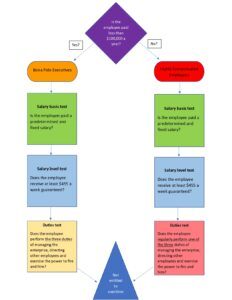Content Highlights
Executives and overtime usually go together like oil and water. However, did you know that certain exemptions could result in your employer owing you thousands in unpaid overtime? Read on to learn what the Supreme Court recently ruled on this subject.
At Gardner Employment Law, we always stay on top of recent developments in the employment law field. If you would like to know more about these exemptions or the Supreme Court’s recent decision, feel free to reach out to us.
How to Determine Executives’ Overtime Exemptions
We created an easy flow chart to assist in figuring out the requirements for executives and overtime.
What is the Bona Fide Executive Exemption?
Highly-paid employees who (1) receive a predetermined and fixed salary, (2) are paid at least $455 per week, and (3) manage operations, direct employees, and can hire and fire fall into the overtime exemption of “bona fide executives.” This three-part analysis is illustrated in the flowchart above. Coming under this exemption means that the employee is exempt from, or cannot receive, overtime pay. Generally, employees who work more than forty hours a week are entitled to overtime pay. However, bona fide executives are not because they are “exempt” from receiving overtime as a matter of law. These overtime rules come under the the FLSA (Fair Labor and Standards Act).
There are three parts of the bona fide executive exemption, and the first element is the “salary basis test.” Simply put, an employee must receive a predetermined and fixed salary for their work, not wages that fluctuate based on the number of hours or the number of days worked. The salary is the same no matter what hours your work and no matter what days you work. In other words, the salary cannot vary. It is not unusual for executives to work 14-18 hour days six days a week, especially in pressure-cooker positions. But they get no more compensation for those long hours, only the predetermined fixed amount.
Second is the “salary level test,” which requires an employee to receive a guaranteed salary of at least $455 a week. Note that these two elements are separate, but do have a lot of overlap. Not every salary is based on a weekly rate, and not everyone has such a straightforward pay scheme. If your contract provides for an annual rate, that amount is divided by 52 to determine the weekly amount. Theoretically, an employee who is paid $450 per week in salary will not be exempt from the requirement to pay him or her for overtime.
Third is the “duties test.” This element requires an employee to have three categories of responsibility to come within the bona fide executive exemption. Those three duties are managing the enterprise, directing other employees, and exercising the power to fire and hire. An employee must perform all three of these duties to be a bona fide executive.
Let’s say you are working as a manager of a large department store in a national chain. You have a yearly salary of $152,000 and get paid the same amount every two weeks regardless of how many hours you worked. You work long hours to build your store’s revenues. Your duties include things like managing the store, directing other employees, hiring new employees, but you do not have the authority to fire anyone. Your supervisor, maybe the regional manager, is the one who has the authority to fire employees. In this hypothetical, you are being paid a fixed salary (satisfies the “salary basis test”) that is more than $455 a week regardless of how many hours you work (satisfies the “salary level test”). You manage the operations, you direct employees in their tasks, you hire new employees – but you do not have the authority to terminate any employee. By not giving you this authority, your employer did not satisfy the “duties test.” Are you entitled to overtime pay? Let’s review the next exemption.
What is the Highly Compensated Employee Exemption?
The “highly compensated employee exemption” is another overtime exemption that covers employees who make over $100,000 a year with the requirement of performing only of the three duties explained above. Oftentimes this exemption is lumped in with the bona fide executive exemption since they are quite similar. However, there are a two key features which distinguish these exemptions. The biggest distinction is that the bona fide executive exemption in the previous section is available only to employees making less than $100,000 a year. If you make more than $100,000, then you come within the “highly compensated” employee exemption if you also have authority to manage operations or direct employees or hire and fire.
The duties test is slightly modified for highly compensated employees, with the difference being that highly compensated employees must regularly perform only one of the three listed duties in order to be exempt from the requirement to pay overtime. Many times a highly compensated employee does have the responsibility for all three areas, but only one is required to put the $100,000+ annually paid employee into the exemption. Our department store manager in the hypothetical above would be exempt from claiming overtime under the highly paid employee exemption.
What Does the Supreme Court Have to Say About These Exemptions?
Just a few weeks ago, the Supreme Court issued its opinion in Helix Energy Solutions Group, Inc. v. Hewitt, No. 21-984, holding that Mr. Hewitt, who earned over $200,000 per year, did not meet the requirements for either the bona fide executive exemption or the highly paid employee exemption. While this decision may have come as a surprise to some, it is generally seen as a victory for employees who are pleased to be paid overtime when they work long hours. Given this ruling, employers need to be certain that their pay scheme is in line with both the Court’s opinion and the standards outlined in the FLSA.
The facts of the Helix case are interesting. Michael Hewitt worked as a “tool pusher” on Helix’s offshore oil rig between 2014 and 2017. During this time, Mr. Hewitt regularly supervised between 12 and 14 workers. As is typical for the grueling job of working on an offshore oil rig, Mr. Hewitt generally worked 7 days a week for 12 hours a day (roughly 84 hours a week). This schedule was the norm during the 28-day “hitches” he would work (followed by 28 days off before reporting back to the vessel). Despite his harrowing schedule, his employer, Helix Energy, considered Mr. Hewitt to be exempt from overtime as a highly compensated employee. However, the Supreme Court held that Helix failed to satisfy the salary requirements to come within the highly compensated employee exemption and that Mr. Hewitt was entitled to overtime pay.
The pay scheme for Mr. Hewitt’s salary was complicated to say the least. Helix paid Mr. Hewitt on a daily rate basis which fluctuated between $963 and $1,341 per day over the course of his employment. Even though he was paid at a daily rate, Mr. Hewitt received his paycheck every two weeks. To calculate his paycheck, Helix would multiply the number of days he worked by the daily rate he was being paid. When Mr. Hewitt was paid $963 every day, Helix easily could calculate paychecks over any given 14 day period (his pay period). If he worked any less than one day, he would make zero dollars. If he worked one day, he would make $963. Working the full 14 days would result in a gross payment of $13,482 in wages. Due to his high daily rate, Helix paid Mr. Hewitt roughly $200,000 annually.
While our flowchart is a helpful guide which appears to follow the FLSA requirements, the Supreme Court looked at the tests in a different order. Since Mr. Hewitt was paid more than $100,000 a year and supervised employees, he should qualify for the highly compensated employee exemption. Further, Mr. Hewitt appeared to satisfy the highly compensated employee duties test because he regularly performed one of the three duties (directing other employees). However, the issue was whether Helix paid Mr. Hewitt a predetermined fixed salary to satisfy the first two prongs, the salary basis and salary level elements. The Court mainly looked at the salary basis test for their analysis since you cannot properly run the salary level test if you are not receiving a salary at all.
The Court held that Mr. Hewitt was not in fact receiving a “salary” for the purposes of the salary basis test because his pay structure was not in line with the concept of a fixed salary. In the words of the Court, the “concept of ‘salary’ is linked, ‘[a]s a matter of common parlance,’ to ‘the stability and security of a regular weekly, monthly, or annual pay structure.’ ” Mr. Hewitt was paid based on the number of days that he worked. If he worked only one day during a pay period, his paycheck was much lower than when he worked the entire fourteen days, which could cause his paychecks to fluctuate in amount. Because Mr. Hewitt’s pay was not predetermined and fixed like a traditional salary, it not pass the salary basis test. He was not exempt from the requirement of paying him overtime. Due to Helix’s misclassifying Mr. Hewitt as a highly paid employee and never paying him any overtime, Helix now owed Mr. Hewitt thousands of dollars in unpaid overtime.
Why Do These Exemptions and This Case Matter?
Misclassifying an employee (as Helix did) can result in thousands of dollars in overtime pay being owed. If you are an employee who has been misclassified as being exempt from overtime requirements, you may be owed thousands of dollars in unpaid overtime.
This blog presents only a cursory look at these exemptions and this Supreme Court opinion. To fully understand the ins and outs of these exemptions, you need to contact an experienced employment attorney who knows precisely how all of these exemptions work. If you want to know more about these exemptions and whether or not you are classified properly, contact us today.


